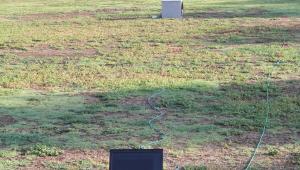Review: Monster ClarityHD Micro Page 2
Measurements
Frequency response
68 Hz to 20 kHz ±4.8 dB on-axis, ±4.3 dB avg 0-30°
Bass limit
80 Hz at 84.1 dB
To measure the quasi-anechoic frequency response of the ClarityHD Micro, I set it atop a 2-meter stand and placed the microphone at a distance of 1 meter. (Quasi-anechoic measurements eliminate reflections from surrounding objects to simulate measuring in an anechoic chamber.) I then ran a close-miked measurement of the passive radiator to get the bass response. To create the graph shown here, I spliced the bass response to the average of quasi-anechoic measurements of the left channel only taken at 0°, ±10°, ±20°, and ±30°. I used a Clio FW analyzer in MLS mode for the quasi-anechoic measurements and log chirp mode for the close-miked sweep, feeding the test signals into the ClarityHD Micro’s 3.5mm line input. The quasi-anechoic measurements were smoothed to 1/12th octave. The blue trace shows the 0° on-axis response, while the green trace shows the averaged response.
The ClarityHD Micro’s frequency response looks admirably smooth, but there’s an obvious uptilt in the tonal balance. Almost the entire treble band from 3 to 20 kHz is boosted, by a max of +7.9 dB. In a product with very limited bass output such as the Micro, this kind of tonal balance tends to sound especially bright. Averaged off-axis response is almost the same as on-axis response, which is admirable although it’s what you’d expect from such small drivers.
To gauge the ClarityHD Micro’s bass output, I used CEA-2010 measurement technique at a distance of 1 meter. Maximum bass output is actually pretty good for a device of this size, suggesting that the bass could have been pumped up by at least a few dB without causing distortion problems.
Bottom line
Although the ClarityHD Micro has a nice design, and seems to have the technical capability to perform really well, I don’t consider its sound quality competitive with that of my favorite products in this category.

























































